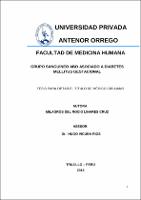Grupo sanguíneo ABO asociado a diabetes mellitus gestacional

Ver/
Descargar
(application/pdf: 607.5Kb)
(application/pdf: 607.5Kb)
Fecha
2018Autor(es)
Linares Cruz, Milagros del Rocio
Metadatos
Mostrar el registro completo del ítemResumen
OBJETIVO: Determinar si el grupo sanguíneo ABO es un factor asociado a
diabetes mellitus gestacional.
MATERIAL Y MÉTODO: Estudio transversal correlacional de pacientes
atendidas entre el período de enero del 2010 a diciembre del 2016. La población
de pacientes del Hospital Regional Docente de Trujillo y del Hospital Belén de la
misma ciudad totalizaron 1386, de los cuales 180 presentaron diabetes mellitus
gestacional y 1206 no, seleccionados aleatoriamente de la población hospitalaria
de estudio.
RESULTADOS: La frecuencia de diabetes mellitus gestacional fue 13%. La edad
promedio de los pacientes con y sin diabetes mellitus gestacional fue 28.86 ±
7.19 y 26.89 ± 6.92 años respectivamente. El tipo de grupo sanguíneo fue de
86.1%, 10%, 3.5% y 0.4% para O, A, B y AB respectivamente. En relación a la
asociación entre el grupo sanguíneo ABO y la presencia de diabetes mellitus
gestacional, el análisis bivariado mostró que el grupo A presentó diferencia
estadísticamente significativa (p=0.03; OR=1.63 IC95%:1.032-2.583) y el
multivariado no mostró diferencia estadística significativa en alguno de ellos
(p>0.05). En cuanto a características generales hubo diferencia estadísticamente
significativa en edad, multiparidad y antecedente familiar de diabetes (p<0.01).
CONCLUSIONES: El grupo sanguíneo ABO no es un factor asociado a diabetes
mellitus gestacional; el grupo A mostró ser un factor únicamente en el análisis
bivariado; variables secundarias como multiparidad y antecedente familiar de
diabetes resultaron estar asociadas a diabetes mellitus gestacional. OBJECTIVE: Determine if the ABO blood group is a factor associated with
gestational diabetes mellitus.
MATERIAL AND METHODS: correlational cross-sectional study of patients
attended between the period of January 2010 to December 2016. The patient
population of the teaching Regional Hospital of Trujillo and the Bethlehem
Hospital of the same city totaled 1386, of which 180 had gestational diabetes
mellitus and 1206 did no, randomly selected from the study hospital population.
RESULTS: the frequency of gestational diabetes mellitus was 13 %. The average
age of patients with and without gestational diabetes mellitus was 28.86 ± 7.19
and 26.89 ± 6.92 years respectively. The typo of blood group was 86.1%, 10%,
3.5% and 0.4% for O,A,B and AB respectively. In relation to the association
between the ABO blood group and the presence of gestational diabetes mellitus,
the bivariate analysis showed that group A presented a statistically significant
difference (p=0.03; OR=1.63 IC95%:1.032-2.583) and the multivariate did not
show significant statistical difference in some of them (p>0.05). Regarding
general characteristics, there was a statistically significant difference in age,
multiparity and family history of diabetes (p<0.01).
CONCLUSIONS: The ABO blood group is not a factor associated with gestational
diabetes mellitus; group A showed to be a factor only in the bivariate analysis;
secondary variables such as: multiparity and family history of diabetes were found
found to be associated with gestational diabetes mellitus.
Palabras clave
Colecciones
- Medicina Humana [3196]

